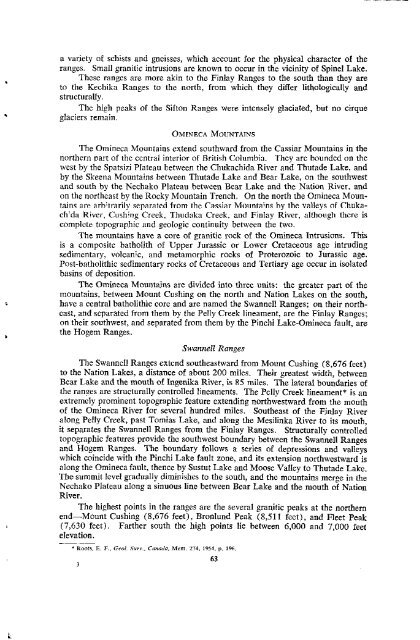Landforms of British Columbia 1976 - Department of Geography
Landforms of British Columbia 1976 - Department of Geography
Landforms of British Columbia 1976 - Department of Geography
Create successful ePaper yourself
Turn your PDF publications into a flip-book with our unique Google optimized e-Paper software.
a variety <strong>of</strong> schists and gneisses, which account for the physical character <strong>of</strong> the<br />
ranges. Small granitic intrusions are known to occur in the vicinity <strong>of</strong> Spine1 Lake.<br />
These ranges are more akin to the Finlay Ranges to the south than they are<br />
to the Kechika Ranges to the north, from which they differ lithologically and<br />
structurally.<br />
The high peaks <strong>of</strong> the Sifton Ranges were intensely glaciated, but no cirque<br />
glaciers remain.<br />
OMINECA MOUNTAINS<br />
The Omineca Mountains extend southward from the Cassiar Mountains in the<br />
northern nart <strong>of</strong> the central interior <strong>of</strong> <strong>British</strong> <strong>Columbia</strong>. They are bounded on the<br />
west by the Spatsizi Plateau between the Chukachida River and Thutade Lake, and<br />
by the Skeena Mountains between Thutade Lake and Bear Lake, on the southwest<br />
and south by the Nechako Plateau between Bear Lake and the Nation River, and<br />
on the northeast by the Rocky Mountain Trench. On the north the Omineca Moun-<br />
tains are arbjtrarily separated from the Cassiar Mountains by the valleys <strong>of</strong> Chuka-<br />
ch’da River, Gushing Creek, Thudaka Creek, and Finlay River, although there is<br />
complete topographic and geologic continuity between the two.<br />
The mountains have a core <strong>of</strong> granitic rock <strong>of</strong> the Omineca Intrusions. This<br />
is a composite batholith <strong>of</strong> Upper Jurassic or Lower Cretaceous age intruding<br />
sedimentary, volcanic, and metamorphic rocks <strong>of</strong> Proterozoic to Jurassic age.<br />
Post-batholithic sedimentary rocks <strong>of</strong> Cretaceous and Tertiary age occur in isolated<br />
basins <strong>of</strong> deposition.<br />
The Omineca Mountains are divided into three units: the greater part <strong>of</strong> the<br />
mountains, between Mount Cushing on the north and Nation Lakes on the south,<br />
have a central batholithic core and are named the Swannell Ranges; on their north-<br />
east, and separated from them by the Pelly Creek lineament, are the Finlay Ranges;<br />
on their southwest, and separated from them by the Pinchi Lake-Omineca fault, are<br />
the Hogem Ranges.<br />
Swannell Ranges<br />
The Swannell Ranges extend southeastward from Mount Cushing (8,676 feet)<br />
to the Nation Lakes, a distance <strong>of</strong> about 200 miles. Their greatest width, between<br />
Bear Lake and the mouth <strong>of</strong> Ingenika River, is 85 miles. The lateral boundaries <strong>of</strong><br />
the ranges are structurally controlled hneaments. The Pelly Creek lineament* is an<br />
extremely prominent topographic feature extending northwestward from the mouth<br />
<strong>of</strong> the Omineca River for several hundred miles. Southeast <strong>of</strong> the Finlay River<br />
along Pelly Creek, past Tomias Lake, and along the Mesilinka River to its mouth,<br />
it separates the Swannell Ranges from the Finlay Ranges. Structurally controlled<br />
topographic features provide the southwest boundary between the Swannell Ranges<br />
and Hogem Ranges. The boundary follows a series <strong>of</strong> depressions and valleys<br />
which coincide with the Pinchi Lake fault zone, and its extension northwestward is<br />
along the Omineca fault, thence by Sustut Lake and Moose Valley to Thutade Lake.<br />
The summit level gradually diminishes to the south, and the mountains merge in the<br />
Nechako Plateau along a sinuous line between Bear Lake and the mouth <strong>of</strong> Nation<br />
River.<br />
The highest points in the ranges are the several granitic peaks at the northern<br />
end-Mount Gushing (8,676 feet), Bronlund Peak (8,51 I feet), and Fleet Peak<br />
(7,630 feet). Farther south the high points lie between 6,000 and 7,()00 feet<br />
elevation.<br />
* Roots, E. F.s Geol, Surv., Canada, Mem. 214, 1954, p. 196.<br />
63<br />
3











